
Tâmpa, Brasov
Encyclopedia
Tâmpa is a mountain, part of the Postăvarul Massif, located in the southern part of the Eastern Carpathians
(alternatively categorized as in the Curvature Carpathians) and almost entirely surrounded by the city of Braşov
. Its elevation is 960 m (995 m according to some sources), almost 400 m above the city.
The mountain is mostly made up of limestone
formations, having risen up gradually from the Earth's crust
.
Most of the mountain (1.5 km²) is a declared nature reserve
, due to the rare animal species (bear
s, bird
s, butterflies
—35% of Romania
n butterfly species) and plant species (a rare Liverleaf
variety, Transylvania
n Windgrass) that are found there. A number of routes to the summit exist: there are 25 winding paths cut in 1837 by Braşov's forest administration; Gabony's stairs; the Knights' road, dating to the days of the Braşovia citadel; and an auto road. A cable car
makes the journey between the cabin/restaurant Casa Pădurarului at the base of the mountain to the Restaurantul Panoramic, on its crest, in under three minutes. The view from the summit is spectacular, offering a panoramic view of the city; on a clear day, the entire Burzenland
is visible.



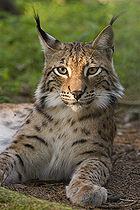


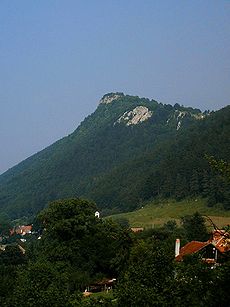 Sextil Puşcariu had this to ask about the etymology of the word Tâmpa: "How is it that Romanians, who usually have such evocative names for their mountains, such as Omul ["the man"], Babele ["the old women"], Strunga ["the vale"] and other names found in the nearby Bucegi
Sextil Puşcariu had this to ask about the etymology of the word Tâmpa: "How is it that Romanians, who usually have such evocative names for their mountains, such as Omul ["the man"], Babele ["the old women"], Strunga ["the vale"] and other names found in the nearby Bucegi
, in this case gave such an unfit name that reminds one of the words tâmp ["stupid"] and tâmpit ["idiot"]?" He accepted the explanation of N. Drăganu, who posited that the original meaning of the word was "abrupt cliff", describing the mountain's two peaks (Big Tâmpa and Little Tâmpa). The word is an old one in Romanian
, dating to pre-Roman times, and also found in southern Italian
dialects and in the Arbëresh language
. However, this is not the only extant theory.
Archaeological evidence indicates that the Dacians
, who worshiped gods in the heavens, built altars on Tâmpa for sacrifices. After the Romans
under Trajan
conquered Dacia, they may have named the altars they found "Tempus / Temporis" ("time"), transferring worship at the site to Saturn
, who was, through his connection to Cronus
, the god of time. In time, the name changed to "Tempea / Tâmpa". According to this version, when the Teutonic Knights
settled in the area, translated the citadel's old name into German
; "the citadel of time" or "the citadel of Cronus" became "Kronstadt", the German name for Braşov.
Through the years, Tâmpa has been relatively safe from natural disasters like mudslides or earthquakes. The most severe damage has been caused by fires, particularly those of 1689, 1731, 1860, 1880 and 1946.
 Braşovia Citadel was one of the seven castles that provided the German name for Transylvania
Braşovia Citadel was one of the seven castles that provided the German name for Transylvania
: Siebenbürgen. The building, located between the peak and the crest of Tâmpa, is presumed to have been raised in the time of the Teutonic Knights
(1212–1218), or if not, was certainly fortified then. In 1241, several Braşov families were able to shelter themselves there from Tatar
raids. In 1397, before the war against the Turks began, Mircea I of Wallachia
placed his family safe in the citadel. In 1421, the people of Braşov took refuge in the citadel, threatened as they were by Sultan Murad II
. That year, the citadel was given as surety to the sultan, as the Turks dominated the city from on high. Thus, the fortification became dangerous for Braşov's inhabitants and for the entire area. After succeeding in taking it back, with the help of John Hunyadi
, the inhabitants decided to demolish it. Its stones were used to fortify the citadel in the valley, then just being built.
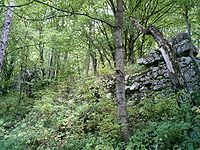 The citadel was made of stone, with a small polygonal tower on the west side, on Tâmpa's peak. Along the walls were found small towers for defence. Within the southern walls, traces of small rooms have been discovered. There was also a deep well and a chapel inside. As the fortification was surrounded by precipices on three sides and was well-defended on its fourth, it was one of the most difficult to capture in Transylvania (indeed in all of Europe), and was in fact never occupied by force, only being handed over through treaties. Provisions were brought to it by people from a narrow valley called Cutun, to which it was linked by Drumul Cavalerilor (the Knights' Road). Around 1910, Costantin Lacea wrote that "even today the Romanian populace, especially the Costeni (inhabitants of Coastei and Costiţei Streets), led by Junii Curcani ("the Young Turkeys"), go out the day after Pentecost
The citadel was made of stone, with a small polygonal tower on the west side, on Tâmpa's peak. Along the walls were found small towers for defence. Within the southern walls, traces of small rooms have been discovered. There was also a deep well and a chapel inside. As the fortification was surrounded by precipices on three sides and was well-defended on its fourth, it was one of the most difficult to capture in Transylvania (indeed in all of Europe), and was in fact never occupied by force, only being handed over through treaties. Provisions were brought to it by people from a narrow valley called Cutun, to which it was linked by Drumul Cavalerilor (the Knights' Road). Around 1910, Costantin Lacea wrote that "even today the Romanian populace, especially the Costeni (inhabitants of Coastei and Costiţei Streets), led by Junii Curcani ("the Young Turkeys"), go out the day after Pentecost
up to the Citadel on Tâmpa, near the Cross of Cutun, and celebrate there. The old people tell how when they were young they used to play up in the Citadel on Tâmpa".
 In the 15th century, two watchtowers were built at the base of Tâmpa, linked to the citadel through a series of walls, which, taken together, extended from the towers to the peak of the mountain. Probably left to decay after the introduction of firearms, the two towers were demolished in the 18th century (two engravings from that century show Tâmpa first with, then without them). Turnul Cuţitarilor (the Knife-Makers' Tower), located to the right of Bastionul Ţesătorilor (the Weavers' Bastion), offered an open view toward the valley (Şchei). No trace of it exists today. Turnul Cizmarilor (the Boot-Makers' Tower), located above Bastionul Postăvarilor (the Drapers' Bastion), dominated Blumăna and Curmătura (the area between Tâmpa and Dealul Melcilor - "the Hill of Snails"). Today, the tower's platform, as well as a good part of the base of the linking wall built on the mountain, still remain.
In the 15th century, two watchtowers were built at the base of Tâmpa, linked to the citadel through a series of walls, which, taken together, extended from the towers to the peak of the mountain. Probably left to decay after the introduction of firearms, the two towers were demolished in the 18th century (two engravings from that century show Tâmpa first with, then without them). Turnul Cuţitarilor (the Knife-Makers' Tower), located to the right of Bastionul Ţesătorilor (the Weavers' Bastion), offered an open view toward the valley (Şchei). No trace of it exists today. Turnul Cizmarilor (the Boot-Makers' Tower), located above Bastionul Postăvarilor (the Drapers' Bastion), dominated Blumăna and Curmătura (the area between Tâmpa and Dealul Melcilor - "the Hill of Snails"). Today, the tower's platform, as well as a good part of the base of the linking wall built on the mountain, still remain.
On the map prepared by Giovanni Morando Visconti in 1699, one can see a cross above Braşov, on the peak of Tâmpa. The Saxon author Thomas Tartler confirms this; he wrote, "there was a cross as big as a crucifix, as the Papists have called Tâmpa the Hill of the Cross (Kreutzberg)". The cross belonged to the Romanians from Şchei, who would raise (with or without the citadel authorities' approval) crosses all through the valley, sometimes even at very short distances from the city walls. One chronicle states that the Tâmpa cross was built on August 2, 1696, attributing it to the carpenters of Emperor Hussein.
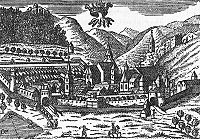 Around 1714 (according to other sources 1696 or 1718), the Braşov senator Johann Draudt, having converted to Catholicism, raised a chapel on Tâmpa, dedicated to Saint Leonard
Around 1714 (according to other sources 1696 or 1718), the Braşov senator Johann Draudt, having converted to Catholicism, raised a chapel on Tâmpa, dedicated to Saint Leonard
. After this was built, in stages, thieves or Lutherans robbed or desecrated the house of worship. On June 10, 1737, the day after Pentecost, at three in the afternoon, "lightning struck the chapel, in front of the altar, hitting a Papist German tailor and his wife, who had taken shelter there... Their dog was also struck". In time, only ruins were left of the chapel. For a long time afterward, Tâmpa was called Chapel Hill (Kapellenberg in German). Often, the Romanians of Şchei were blamed for the chapel's destruction: one writer said that they broke its door, hurled it into the valley, and stole several objects from within.
In 1849, after the Imperial Russian intervention in support of the Austrian Monarchy
(see Hungarian Revolution of 1848
), Tâmpa became home to a pyramid
-shaped monument, raised on the initiative of Lieutenant General
von Hassfort and bearing the inscription Rusia et Austria unitæ MDXXXIL
("Russia and Austria united 1849"). Heavily damaged by either natural causes or, according to George Bariţ
, human intervention ("adverse hands"), the pyramid was ultimately removed by Austro-Hungarian
authorities on April 7, 1869.
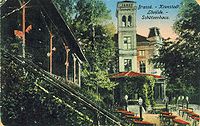 After 1865, Tâmpa housed the Schützenhaus (the "Shooting range
After 1865, Tâmpa housed the Schützenhaus (the "Shooting range
"), soon a favorite with the city's male population. Aside from fire practice, the location had a bowling
lane and a restaurant
; it was decorated with numerous hunting
trophies
and mannequin
s dressed in plate armors. The building was badly damaged by a 1916 fire, and for a long time remained derelict. Ultimately, the Dr. Nicolae Rucăreanu High School of Silviculture
was raised on the location — the plot remains disputed between the Evangelical Church and the city of Braşov.
 In 1896, upon celebrating the 1000th anniversary of Magyar tribes settling in Pannonia
In 1896, upon celebrating the 1000th anniversary of Magyar tribes settling in Pannonia
under the leadership of Árpád
(see Pannonian basin before Hungary), seven commemorative statues were raised throughout the Hungarian Kingdom
. On this occasion, a monumental column
topped by the statue of a Magyar archer
— popularly identified with Árpád himself —, was erected on Tâmpa, causing controversy inside the Romanian
community. Stone used for the monument had been transported up the slope by a funicular
, and the completed monument featured a lightning rod
; overall, it cost 22,585 florins
to build.
The new monument was first damaged by a bomb placed at its base, an attack carried out by two terrorists against Hungarian rule (Ilie Cătărău
and Timofei Kirilov) in September, 1913. In December of the same year, the monument was heavily damaged by a thunderstorm
: the "Árpád statue" fell from atop the column and shattered into pieces. In 1916, the remaining parts were detonated by the Romanian Army during its World War I
advance into Transylvania
(see Romanian Campaign
). The statue's debris was removed by Communist Romania
n authorities in 1966, and the head is preserved by the Parish House of the Reformed Church in Braşov
. Tâmpa still houses the base of the monument.
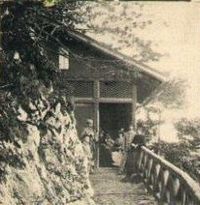
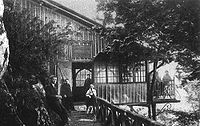 Around 1890, the mountain became home to a restaurant and public house
Around 1890, the mountain became home to a restaurant and public house
, owned by the patrons of the Schützenhaus and named Béthlen (or Béthlen Grotto
) in 1891, in honour of a Hungarian minister who had visited the city during that year. Supplied every day by the tenant, who led his donkey up 25 serpentine windings, it became a regular spot for city residents who were attracted by the panoramic scenery of Braşov at nighttime; in 1905, it was equipped with a terrace
reaching over the steep slope. The restaurant's name was changed to Cabana-restaurant "Tâmpa" ("The Tâmpa Cabin-Restaurant") in 1948. On March 23, 1977, the entire building burned down following an accident. The terrace and stone recipients for beer are still in place; in 2001, the Braşov County
Council erected a marble cross on the perimeter; the lit sign bearing the name Braşov was restored in 2006.
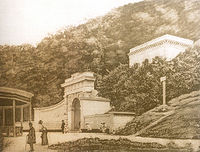 Also in 1891-1892, the Braşov Aqueduct
Also in 1891-1892, the Braşov Aqueduct
was erected on the Tâmpa ridge, under the direction of engineer Christian Kertsch (best remembered for his Kertsch House in downtown Braşov). Water was carried through ceramic
pipes over a great distance, from springs on the other side of Tâmpa. Pipe deterioration eventually forced Braşov authorities to provide the aqueduct with water from the city area (popular myth still has it that water running through the aqueduct is spring water, and, occasionally, people still supply themselves directly from that location). Shards of ceramic pipes and a memorial plaque to the engineer P. Bartusch are still visible on the way to Râpa Dracului (going around the mountain).
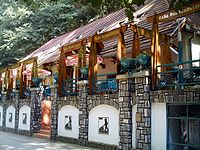 Casa Pădurarului ("the Woodman's House") is a rustic restaurant located at the base of Tâmpa, about halfway along the pedestrian road there. Built at the beginning of the 20th century, it served as a place of rest for the residents of Braşov who would walk along the promenade below Tâmpa. Near this restaurant, rebuilt in the 2000s after suffering a fire, the cable car starts its course, taking passengers in less than three minutes to the Panoramic restaurant, located atop the mountain.
Casa Pădurarului ("the Woodman's House") is a rustic restaurant located at the base of Tâmpa, about halfway along the pedestrian road there. Built at the beginning of the 20th century, it served as a place of rest for the residents of Braşov who would walk along the promenade below Tâmpa. Near this restaurant, rebuilt in the 2000s after suffering a fire, the cable car starts its course, taking passengers in less than three minutes to the Panoramic restaurant, located atop the mountain.
In 1968-1969, a television tower as well as a restaurant and a cable car were built on Tâmpa's crest. Today, the tower receives a signal from Postăvaru and transmits it to the city below (initially with 10 kW, but today with just 2 kW), while the Panoramic restaurant, situated in a favourable location, offers excellent views of the city from its dining hall. The Aro-Palace society owns the restaurant. The cable car terminus is also located beneath the tower. Before 1989, when tourists exited the cable car, they were met by an enormous stuffed brown bear, standing menacingly on two feet. At the same time as this complex was built, a short distance away, a flagpole was built. In 2004, the Braşov County Council guaranteed festive lighting for it, installing a powerful laser reflector that lights up the sky a good part of every evening.
connecting Casa Sfatului with a cave under Şaua Tâmpei, in which German
prisoners of war
were held during World War I
, with both ends of the tunnel blocked.
At the beginning on the 1940s, there was a proposal to dig a tunnel under Mount Tâmpa, to connect the Old City with Valea Cetăţii neighborhood. After Romania entered World War II, the project was abandoned. During the Communist period
, when massive construction projects were undertaken in Răcădău, with over 10,000 apartments built, the plans for the tunnel were resurrected. One such plan, drafted in 1979, envisioned an East-West tunnel, with a length of 842 m, width of 9.8 m, and height of 7.65 m. The construction would have involved excavating 100,000 m³ of rock, at a cost (in 1984) of 163 million lei
. Another estimate, done in 2003 by the Braşov County
Council, put the cost of building the tunnel ar near 11 million euro
s.
A long-held belief is that there is a big lake inside the mountain. Drilling the tunnel may lead to flooding the city. Yet no concrete evidence of such a lake has ever been found.
What is known for sure is that there are three or four tunnels under Tâmpa, only one of which is usable at present. This tunnel connects Casa Sfatului with one of the towers of the old citadel (Turnul Cuţitarilor or Bastionul Postăvarilor). Due to the danger of cave-ins the tunnels pose, they are all shut with metal grates. It is said that during the bombing of Romania in World War II
, one of the tunnels was blocked by debris, burying alive those people who had taken refuge in there.
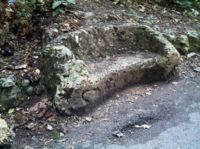 At the foot of Tâmpa, along the southeast side of the old fortress walls, there is a tree-lined path—a favorite strolling spot for the inhabitants. Among the wooden benches lining the path, there lies a small bench carved from a rock. It is said that the rock fell from the mountain, burying two lovers that were embracing on that place. A document from 1817 mentions the story, giving the name of the woman killed by the rock as Ana Maria.
At the foot of Tâmpa, along the southeast side of the old fortress walls, there is a tree-lined path—a favorite strolling spot for the inhabitants. Among the wooden benches lining the path, there lies a small bench carved from a rock. It is said that the rock fell from the mountain, burying two lovers that were embracing on that place. A document from 1817 mentions the story, giving the name of the woman killed by the rock as Ana Maria.
was renamed Oraşul Stalin
(see List of places named after Stalin), the authorities started planting fir trees, so that the word "STALIN" would be clearly visible from the city. Over the years, vegetation has blurred the word made out by the trees. Yet, to this day (especially in the winter), one may still distinguish the marking "ALIN" when coming on the road from the Burzenland.
is nicknamed Diavolii de sub Tâmpa (The Tâmpa Devils).
Carpathian Mountains
The Carpathian Mountains or Carpathians are a range of mountains forming an arc roughly long across Central and Eastern Europe, making them the second-longest mountain range in Europe...
(alternatively categorized as in the Curvature Carpathians) and almost entirely surrounded by the city of Braşov
Brasov
Brașov is a city in Romania and the capital of Brașov County.According to the last Romanian census, from 2002, there were 284,596 people living within the city of Brașov, making it the 8th most populated city in Romania....
. Its elevation is 960 m (995 m according to some sources), almost 400 m above the city.
The mountain is mostly made up of limestone
Limestone
Limestone is a sedimentary rock composed largely of the minerals calcite and aragonite, which are different crystal forms of calcium carbonate . Many limestones are composed from skeletal fragments of marine organisms such as coral or foraminifera....
formations, having risen up gradually from the Earth's crust
Crust (geology)
In geology, the crust is the outermost solid shell of a rocky planet or natural satellite, which is chemically distinct from the underlying mantle...
.
Most of the mountain (1.5 km²) is a declared nature reserve
Nature reserve
A nature reserve is a protected area of importance for wildlife, flora, fauna or features of geological or other special interest, which is reserved and managed for conservation and to provide special opportunities for study or research...
, due to the rare animal species (bear
Bear
Bears are mammals of the family Ursidae. Bears are classified as caniforms, or doglike carnivorans, with the pinnipeds being their closest living relatives. Although there are only eight living species of bear, they are widespread, appearing in a wide variety of habitats throughout the Northern...
s, bird
Bird
Birds are feathered, winged, bipedal, endothermic , egg-laying, vertebrate animals. Around 10,000 living species and 188 families makes them the most speciose class of tetrapod vertebrates. They inhabit ecosystems across the globe, from the Arctic to the Antarctic. Extant birds range in size from...
s, butterflies
Butterfly
A butterfly is a mainly day-flying insect of the order Lepidoptera, which includes the butterflies and moths. Like other holometabolous insects, the butterfly's life cycle consists of four parts: egg, larva, pupa and adult. Most species are diurnal. Butterflies have large, often brightly coloured...
—35% of Romania
Romania
Romania is a country located at the crossroads of Central and Southeastern Europe, on the Lower Danube, within and outside the Carpathian arch, bordering on the Black Sea...
n butterfly species) and plant species (a rare Liverleaf
Hepatica
Hepatica is a genus of herbaceous perennials in the buttercup family, native to central and northern Europe, Asia and eastern North America...
variety, Transylvania
Transylvania
Transylvania is a historical region in the central part of Romania. Bounded on the east and south by the Carpathian mountain range, historical Transylvania extended in the west to the Apuseni Mountains; however, the term sometimes encompasses not only Transylvania proper, but also the historical...
n Windgrass) that are found there. A number of routes to the summit exist: there are 25 winding paths cut in 1837 by Braşov's forest administration; Gabony's stairs; the Knights' road, dating to the days of the Braşovia citadel; and an auto road. A cable car
Cable car
A cable car is any of a variety of transportation systems relying on cables to pull vehicles along or lower them at a steady rate, or a vehicle on these systems.-Aerial lift:Aerial lifts where the vehicle is suspended in the air from a cable:...
makes the journey between the cabin/restaurant Casa Pădurarului at the base of the mountain to the Restaurantul Panoramic, on its crest, in under three minutes. The view from the summit is spectacular, offering a panoramic view of the city; on a clear day, the entire Burzenland
Burzenland
The Burzenland is a historic and ethnographic area in southeastern Transylvania, Romania with a mixed population...
is visible.
Plants




| Common name | Latin name |
|---|---|
| "Braveheart's Cross Hepatica Hepatica is a genus of herbaceous perennials in the buttercup family, native to central and northern Europe, Asia and eastern North America... " |
Hepatica transsilvanica |
| Common Dogwood Common Dogwood The Common Dogwood, Cornus sanguinea, is a species of dogwood native to most of Europe and western Asia, occurring north to southern England and southern Scandinavia, and east to the Caspian Sea. It is widely grown as an ornamental plant.... |
Cornus sanguinea |
| Common Elder Sambucus nigra Sambucus nigra is a species complex of elder native to most of Europe.It is most commonly called Elder, Elderberry, Black Elder, European Elder, European Elderberry, European Black Elderberry, Common Elder, or Elder Bush when distinction from other species of Sambucus is needed... |
Sambucus nigra |
| Common Hazel Common Hazel Corylus avellana, the Common Hazel, is a species of hazel native to Europe and western Asia, from the British Isles south to Iberia, Greece, Turkey and Cyprus, north to central Scandinavia, and east to the central Ural Mountains, the Caucasus, and northwestern Iran. It is an important component of... |
Corylus avellana |
| Cowslip Primula veris Primula veris is a flowering plant in the genus Primula. The species is found throughout most of temperate Europe and Asia, and although absent from more northerly areas including much of northwest Scotland, it reappears in northernmost Sutherland and Orkney.-Names:The common name cowslip derives... |
Primula officinalis |
| "Dwarf Almond Almond The almond , is a species of tree native to the Middle East and South Asia. Almond is also the name of the edible and widely cultivated seed of this tree... " |
Amigdalus nana |
| European Ash European Ash Fraxinus excelsior , is a species of Fraxinus native to most of Europe with the exception of northern Scandinavia and southern Iberia, and also southwestern Asia from northern Turkey east to the Caucasus and Alborz mountains... |
Fraxinus excelsior |
| European Beech European Beech Fagus sylvatica, the European Beech or Common Beech, is a deciduous tree belonging to the beech family Fagaceae.-Natural range:... |
Fagus sylvatica |
| European Cornel European Cornel The European Cornel is a species of dogwood native to southern Europe and southwest Asia. In North America, the plant is known by the common name of Cornelian Cherry.... |
Cornus mas |
| European Hornbeam European Hornbeam Carpinus betulus is a hornbeam native to eastern, western, central and southern England. It requires a warm climate for good growth, and occurs only at elevations up to 600 metres... |
Carpinus betulus |
| European Larch European Larch Larix decidua, common name European larch, is a species of larch native to the mountains of central Europe, in the Alps and Carpathians, with disjunct lowland populations in northern Poland and southern Lithuania.-Description:... |
Larix decidua |
| Feather Grass Stipa pennata Stipa pennata, common name feather grass, is a flowering plant in the family Poaceae, which is grown as an ornamental plant for its feathery flowering spikes.... |
Stipa pennata |
| Forking Larkspur Forking Larkspur Consolida regalis, common name: Royal Knight's-spur or Forking Larkspur, is an annual herbaceous plant belonging to the genus Consolida of the Buttercup family .-Description:... |
Consolida regalis |
| Ground Cherry Prunus Prunus is a genus of trees and shrubs, which includes the plums, cherries, peaches, apricots and almonds. There are around 430 species spread throughout the northern temperate regions of the globe. Many members of the genus are widely cultivated for fruit and ornament.-Botany:Members of the genus... |
Prunus fruticosa |
| Iris Iris (plant) Iris is a genus of 260-300species of flowering plants with showy flowers. It takes its name from the Greek word for a rainbow, referring to the wide variety of flower colors found among the many species... |
Iris germanica |
| Lady's Slipper Cypripedium calceolus Cypripedium calceolus is a lady's-slipper orchid, and the type species of the genus Cypripedium.It is a widespread plant worldwide, found from Europe east through Asia to the Pacific Ocean. It is found in open woodland on moist calcareous soils. It is found in continental Europe growing in the... |
Cypripedium calceolus |
| Large-leaved Linden Tilia platyphyllos Tilia platyphyllos is a deciduous tree native to much of Europe, including locally in southwestern Great Britain, growing on lime-rich soils. The common name Large-leaved Linden is in standard use throughout the English-speaking world except in Britain, where it has largely been replaced by the... |
Tilia platyphyllos |
| "Limestone's Crown" | Spiraea crenata |
| Mountain Elm Elm Elms are deciduous and semi-deciduous trees comprising the genus Ulmus in the plant family Ulmaceae. The dozens of species are found in temperate and tropical-montane regions of North America and Eurasia, ranging southward into Indonesia. Elms are components of many kinds of natural forests... |
Ulmus montana |
| Norway Spruce Norway Spruce Norway Spruce is a species of spruce native to Europe. It is also commonly referred to as the European Spruce.- Description :... |
Picea abies |
| Pedunculate Oak Pedunculate Oak Quercus robur is commonly known as the Pedunculate Oak or English oak. It is native to most of Europe, and to Anatolia to the Caucasus, and also to parts of North Africa.-Taxonomy:Q... |
Quercus robur |
| "Rabbit's Tail" | Sesleria rigida |
| Scots Pine Scots Pine Pinus sylvestris, commonly known as the Scots Pine, is a species of pine native to Europe and Asia, ranging from Scotland, Ireland and Portugal in the west, east to eastern Siberia, south to the Caucasus Mountains, and as far north as well inside the Arctic Circle in Scandinavia... |
Pinus sylvestris |
| Silver Plantain Plantago Plantago is a genus of about 200 species of small, inconspicuous plants commonly called plantains. They share this name with the very dissimilar plantain, a kind of banana. Most are herbaceous plants, though a few are subshrubs growing to 60 cm tall. The leaves are sessile, but have a narrow... |
Plantago argentea |
| "Spotted Tulip Fritillary Fritillaria is a genus of about 100 species of bulbous plants in the family Liliaceae, native to temperate regions of the Northern Hemisphere. The name is derived from the Latin term for a dice-box , and probably refers to the checkered pattern, frequently of chocolate-brown and greenish yellow,... " |
Fritillaria meleagroides |
| "Transylvanian Windgrass" | Bromus marcensis |
| Wild Hyacinth Hyacinthus orientalis Hyacinthus orientalis , is a perennial flowering plant, native to southwestern Asia, southern and central Turkey, northwestern Syria, Lebanon and northern Israel. It was introduced to Europe in the 16th century.It is a bulbous plant, with a 3–7 cm diameter bulb... |
Hyacinthus orientalis |
| Wolfsbane Aconitum Aconitum , known as aconite, monkshood, wolfsbane, leopard's bane, women's bane, Devil's helmet or blue rocket, is a genus of over 250 species of flowering plants belonging to the buttercup family .-Overview:These herbaceous perennial plants are chiefly natives of the mountainous parts of the... |
Aconitum |
| Wood Anemone Anemone nemorosa Anemone nemorosa is an early-spring flowering plant in the genus Anemone in the family Ranunculaceae, native to Europe. Common names include wood anemone, windflower, thimbleweed and smell fox, an allusion to the musky smell of the leaves... |
Anemone nemorosa |
Animals


| Common name | Latin name |
|---|---|
| Brown Bear Brown Bear The brown bear is a large bear distributed across much of northern Eurasia and North America. It can weigh from and its largest subspecies, the Kodiak Bear, rivals the polar bear as the largest member of the bear family and as the largest land-based predator.There are several recognized... |
Ursus arctos |
| Butterflies | Papilionoidea |
| Common Raven Common Raven The Common Raven , also known as the Northern Raven, is a large, all-black passerine bird. Found across the northern hemisphere, it is the most widely distributed of all corvids... |
Corvus corax |
| Eurasian Lynx Eurasian Lynx The Eurasian lynx is a medium-sized cat native to European and Siberian forests, South Asia and East Asia. It is also known as the European lynx, common lynx, the northern lynx, and the Siberian or Russian lynx... |
Lynx lynx |
| European Viper Vipera berus Vipera berus, the common European adder or common European viper, is a venomous viper species that is extremely widespread and can be found throughout most of Western Europe and all the way to Far East Asia. Known by a host of common names including Common adder and Common viper, adders have been... |
Vipera berus |
| Golden Eagle Golden Eagle The Golden Eagle is one of the best known birds of prey in the Northern Hemisphere. Like all eagles, it belongs to the family Accipitridae. Once widespread across the Holarctic, it has disappeared from many of the more heavily populated areas... |
Aquila chrysaetos |
| Gray Wolf Gray Wolf The gray wolf , also known as the wolf, is the largest extant wild member of the Canidae family... |
Canis lupus |
| Red Squirrel Red Squirrel The red squirrel or Eurasian red squirrel is a species of tree squirrel in the genus Sciurus common throughout Eurasia... |
Sciurus vulgaris |
| Other birds | Aves |
| 17 rare Wasp Wasp The term wasp is typically defined as any insect of the order Hymenoptera and suborder Apocrita that is neither a bee nor an ant. Almost every pest insect species has at least one wasp species that preys upon it or parasitizes it, making wasps critically important in natural control of their... species |
Apocrita Apocrita Apocrita is a suborder of insects in the order Hymenoptera.Apocrita includes wasps, bees and ants, and consists of many families. It includes the most advanced hymenopterans and is distinguished from Symphyta by the narrow "waist" formed between the first two segments of the actual abdomen; the... |
Etymology

Bucegi Mountains
The Bucegi Mountains are located in central Romania, south of the city Braşov. They are part of the Southern Carpathians group of the Carpathian Mountains....
, in this case gave such an unfit name that reminds one of the words tâmp ["stupid"] and tâmpit ["idiot"]?" He accepted the explanation of N. Drăganu, who posited that the original meaning of the word was "abrupt cliff", describing the mountain's two peaks (Big Tâmpa and Little Tâmpa). The word is an old one in Romanian
Romanian language
Romanian Romanian Romanian (or Daco-Romanian; obsolete spellings Rumanian, Roumanian; self-designation: română, limba română ("the Romanian language") or românește (lit. "in Romanian") is a Romance language spoken by around 24 to 28 million people, primarily in Romania and Moldova...
, dating to pre-Roman times, and also found in southern Italian
Italian language
Italian is a Romance language spoken mainly in Europe: Italy, Switzerland, San Marino, Vatican City, by minorities in Malta, Monaco, Croatia, Slovenia, France, Libya, Eritrea, and Somalia, and by immigrant communities in the Americas and Australia...
dialects and in the Arbëresh language
Arbëresh language
Arbëreshë, also known as Arbërisht, is an ethnolect spoken by the Arbëreshë, the group of Albanian-speaking minorities in Italy.-Classification:...
. However, this is not the only extant theory.
Archaeological evidence indicates that the Dacians
Dacians
The Dacians were an Indo-European people, very close or part of the Thracians. Dacians were the ancient inhabitants of Dacia...
, who worshiped gods in the heavens, built altars on Tâmpa for sacrifices. After the Romans
Roman Empire
The Roman Empire was the post-Republican period of the ancient Roman civilization, characterised by an autocratic form of government and large territorial holdings in Europe and around the Mediterranean....
under Trajan
Trajan
Trajan , was Roman Emperor from 98 to 117 AD. Born into a non-patrician family in the province of Hispania Baetica, in Spain Trajan rose to prominence during the reign of emperor Domitian. Serving as a legatus legionis in Hispania Tarraconensis, in Spain, in 89 Trajan supported the emperor against...
conquered Dacia, they may have named the altars they found "Tempus / Temporis" ("time"), transferring worship at the site to Saturn
Saturn (mythology)
In ancient Roman religion and myth, Saturn was a major god presiding over agriculture and the harvest time. His reign was depicted as a Golden Age of abundance and peace by many Roman authors. In medieval times he was known as the Roman god of agriculture, justice and strength. He held a sickle in...
, who was, through his connection to Cronus
Cronus
In Greek mythology, Cronus or Kronos was the leader and the youngest of the first generation of Titans, divine descendants of Gaia, the earth, and Uranus, the sky...
, the god of time. In time, the name changed to "Tempea / Tâmpa". According to this version, when the Teutonic Knights
Teutonic Knights
The Order of Brothers of the German House of Saint Mary in Jerusalem , commonly the Teutonic Order , is a German medieval military order, in modern times a purely religious Catholic order...
settled in the area, translated the citadel's old name into German
German language
German is a West Germanic language, related to and classified alongside English and Dutch. With an estimated 90 – 98 million native speakers, German is one of the world's major languages and is the most widely-spoken first language in the European Union....
; "the citadel of time" or "the citadel of Cronus" became "Kronstadt", the German name for Braşov.
History
The oldest human traces on Tâmpa date to the time of the Dacians. On Tâmpa, archeologists have discovered a bone pit from that period, indicating that a pagan cult was practiced there.Through the years, Tâmpa has been relatively safe from natural disasters like mudslides or earthquakes. The most severe damage has been caused by fires, particularly those of 1689, 1731, 1860, 1880 and 1946.

Transylvania
Transylvania is a historical region in the central part of Romania. Bounded on the east and south by the Carpathian mountain range, historical Transylvania extended in the west to the Apuseni Mountains; however, the term sometimes encompasses not only Transylvania proper, but also the historical...
: Siebenbürgen. The building, located between the peak and the crest of Tâmpa, is presumed to have been raised in the time of the Teutonic Knights
Teutonic Knights
The Order of Brothers of the German House of Saint Mary in Jerusalem , commonly the Teutonic Order , is a German medieval military order, in modern times a purely religious Catholic order...
(1212–1218), or if not, was certainly fortified then. In 1241, several Braşov families were able to shelter themselves there from Tatar
Tatars
Tatars are a Turkic speaking ethnic group , numbering roughly 7 million.The majority of Tatars live in the Russian Federation, with a population of around 5.5 million, about 2 million of which in the republic of Tatarstan.Significant minority populations are found in Uzbekistan, Kazakhstan,...
raids. In 1397, before the war against the Turks began, Mircea I of Wallachia
Mircea I of Wallachia
Mircea the Elder was ruler of Wallachia from 1386 until his death. The byname "elder" was given to him after his death in order to distinguish him from his grandson Mircea II...
placed his family safe in the citadel. In 1421, the people of Braşov took refuge in the citadel, threatened as they were by Sultan Murad II
Murad II
Murad II Kodja was the Sultan of the Ottoman Empire from 1421 to 1451 ....
. That year, the citadel was given as surety to the sultan, as the Turks dominated the city from on high. Thus, the fortification became dangerous for Braşov's inhabitants and for the entire area. After succeeding in taking it back, with the help of John Hunyadi
John Hunyadi
John Hunyadi John Hunyadi (Hungarian: Hunyadi János , Medieval Latin: Ioannes Corvinus or Ioannes de Hunyad, Romanian: Iancu (Ioan) de Hunedoara, Croatian: Janko Hunjadi, Serbian: Сибињанин Јанко / Sibinjanin Janko, Slovak: Ján Huňady) John Hunyadi (Hungarian: Hunyadi János , Medieval Latin: ...
, the inhabitants decided to demolish it. Its stones were used to fortify the citadel in the valley, then just being built.

Pentecost
Pentecost is a prominent feast in the calendar of Ancient Israel celebrating the giving of the Law on Sinai, and also later in the Christian liturgical year commemorating the descent of the Holy Spirit upon the disciples of Christ after the Resurrection of Jesus...
up to the Citadel on Tâmpa, near the Cross of Cutun, and celebrate there. The old people tell how when they were young they used to play up in the Citadel on Tâmpa".

On the map prepared by Giovanni Morando Visconti in 1699, one can see a cross above Braşov, on the peak of Tâmpa. The Saxon author Thomas Tartler confirms this; he wrote, "there was a cross as big as a crucifix, as the Papists have called Tâmpa the Hill of the Cross (Kreutzberg)". The cross belonged to the Romanians from Şchei, who would raise (with or without the citadel authorities' approval) crosses all through the valley, sometimes even at very short distances from the city walls. One chronicle states that the Tâmpa cross was built on August 2, 1696, attributing it to the carpenters of Emperor Hussein.

Leonard of Noblac
Leonard of Noblac or of Limoges or de Noblet , is a Frankish saint closely associated with the town and abbey of Saint-Léonard-de-Noblat, in Haute-Vienne, in the Limousin of France.-Traditional biography:According to the romance that...
. After this was built, in stages, thieves or Lutherans robbed or desecrated the house of worship. On June 10, 1737, the day after Pentecost, at three in the afternoon, "lightning struck the chapel, in front of the altar, hitting a Papist German tailor and his wife, who had taken shelter there... Their dog was also struck". In time, only ruins were left of the chapel. For a long time afterward, Tâmpa was called Chapel Hill (Kapellenberg in German). Often, the Romanians of Şchei were blamed for the chapel's destruction: one writer said that they broke its door, hurled it into the valley, and stole several objects from within.
In 1849, after the Imperial Russian intervention in support of the Austrian Monarchy
Austrian Empire
The Austrian Empire was a modern era successor empire, which was centered on what is today's Austria and which officially lasted from 1804 to 1867. It was followed by the Empire of Austria-Hungary, whose proclamation was a diplomatic move that elevated Hungary's status within the Austrian Empire...
(see Hungarian Revolution of 1848
Hungarian Revolution of 1848
The Hungarian Revolution of 1848 was one of many of the European Revolutions of 1848 and closely linked to other revolutions of 1848 in the Habsburg areas...
), Tâmpa became home to a pyramid
Pyramid
A pyramid is a structure whose outer surfaces are triangular and converge at a single point. The base of a pyramid can be trilateral, quadrilateral, or any polygon shape, meaning that a pyramid has at least three triangular surfaces...
-shaped monument, raised on the initiative of Lieutenant General
Lieutenant General
Lieutenant General is a military rank used in many countries. The rank traces its origins to the Middle Ages where the title of Lieutenant General was held by the second in command on the battlefield, who was normally subordinate to a Captain General....
von Hassfort and bearing the inscription Rusia et Austria unitæ MDXXXIL
Roman numerals
The numeral system of ancient Rome, or Roman numerals, uses combinations of letters from the Latin alphabet to signify values. The numbers 1 to 10 can be expressed in Roman numerals as:...
("Russia and Austria united 1849"). Heavily damaged by either natural causes or, according to George Bariţ
George Barit
George Bariţ , often rendered as George Bariţiu, was a Romanian historian, philologist, playwright, politician, businessman and journalist, the founder of the Romanian language press in Transylvania.- Biography :...
, human intervention ("adverse hands"), the pyramid was ultimately removed by Austro-Hungarian
Austria-Hungary
Austria-Hungary , more formally known as the Kingdoms and Lands Represented in the Imperial Council and the Lands of the Holy Hungarian Crown of Saint Stephen, was a constitutional monarchic union between the crowns of the Austrian Empire and the Kingdom of Hungary in...
authorities on April 7, 1869.

Shooting range
A shooting range or firing range is a specialized facility designed for firearms practice. Each facility is typically overseen by one or more supervisory personnel, called variously a range master or "RSO – Range Safety Officer" in the United States or a range conducting officer or "RCO" in the UK...
"), soon a favorite with the city's male population. Aside from fire practice, the location had a bowling
Bowling
Bowling Bowling Bowling (1375–1425; late Middle English bowle, variant of boule Bowling (1375–1425; late Middle English bowle, variant of boule...
lane and a restaurant
Restaurant
A restaurant is an establishment which prepares and serves food and drink to customers in return for money. Meals are generally served and eaten on premises, but many restaurants also offer take-out and food delivery services...
; it was decorated with numerous hunting
Hunting
Hunting is the practice of pursuing any living thing, usually wildlife, for food, recreation, or trade. In present-day use, the term refers to lawful hunting, as distinguished from poaching, which is the killing, trapping or capture of the hunted species contrary to applicable law...
trophies
Trophy (disambiguation)
Trophy or trophies may refer to:* Trophy, an award of a mostly symbolic value, earned by the winner of a competition.*Trophy wife, a term commonly used to describe any wife who is considered a status symbol....
and mannequin
Mannequin
A mannequin is an often articulated doll used by artists, tailors, dressmakers, and others especially to display or fit clothing...
s dressed in plate armors. The building was badly damaged by a 1916 fire, and for a long time remained derelict. Ultimately, the Dr. Nicolae Rucăreanu High School of Silviculture
Silviculture
Silviculture is the practice of controlling the establishment, growth, composition, health, and quality of forests to meet diverse needs and values. The name comes from the Latin silvi- + culture...
was raised on the location — the plot remains disputed between the Evangelical Church and the city of Braşov.

Pannonia
Pannonia was an ancient province of the Roman Empire bounded north and east by the Danube, coterminous westward with Noricum and upper Italy, and southward with Dalmatia and upper Moesia....
under the leadership of Árpád
Árpád
Árpád was the second Grand Prince of the Hungarians . Under his rule the Hungarian people settled in the Carpathian basin. The dynasty descending from him ruled the Hungarian tribes and later the Kingdom of Hungary until 1301...
(see Pannonian basin before Hungary), seven commemorative statues were raised throughout the Hungarian Kingdom
Kingdom of Hungary
The Kingdom of Hungary comprised present-day Hungary, Slovakia and Croatia , Transylvania , Carpatho Ruthenia , Vojvodina , Burgenland , and other smaller territories surrounding present-day Hungary's borders...
. On this occasion, a monumental column
Column
A column or pillar in architecture and structural engineering is a vertical structural element that transmits, through compression, the weight of the structure above to other structural elements below. For the purpose of wind or earthquake engineering, columns may be designed to resist lateral forces...
topped by the statue of a Magyar archer
Archery
Archery is the art, practice, or skill of propelling arrows with the use of a bow, from Latin arcus. Archery has historically been used for hunting and combat; in modern times, however, its main use is that of a recreational activity...
— popularly identified with Árpád himself —, was erected on Tâmpa, causing controversy inside the Romanian
Romanians
The Romanians are an ethnic group native to Romania, who speak Romanian; they are the majority inhabitants of Romania....
community. Stone used for the monument had been transported up the slope by a funicular
Funicular
A funicular, also known as an inclined plane or cliff railway, is a cable railway in which a cable attached to a pair of tram-like vehicles on rails moves them up and down a steep slope; the ascending and descending vehicles counterbalance each other.-Operation:The basic principle of funicular...
, and the completed monument featured a lightning rod
Lightning rod
A lightning rod or lightning conductor is a metal rod or conductor mounted on top of a building and electrically connected to the ground through a wire, to protect the building in the event of lightning...
; overall, it cost 22,585 florins
Austro-Hungarian gulden
The Gulden or forint was the currency of the Austrian Empire and later the Austro-Hungarian Empire between 1754 and 1892 when it was replaced by the Krone/korona as part of the introduction of the gold standard. In Austria, the Gulden was initially divided into 60 Kreuzer, and in Hungary, the...
to build.
The new monument was first damaged by a bomb placed at its base, an attack carried out by two terrorists against Hungarian rule (Ilie Cătărău
Ilie Cătărău
Ilie Cătărău was a Bessarabian-born political adventurer, soldier and spy, who spent parts of his life in Romania. Leading a secretive life, he is widely held to have been the main perpetrator of two bomb attacks, which sought to exacerbate tensions between Romania and Austria-Hungary in...
and Timofei Kirilov) in September, 1913. In December of the same year, the monument was heavily damaged by a thunderstorm
Thunderstorm
A thunderstorm, also known as an electrical storm, a lightning storm, thundershower or simply a storm is a form of weather characterized by the presence of lightning and its acoustic effect on the Earth's atmosphere known as thunder. The meteorologically assigned cloud type associated with the...
: the "Árpád statue" fell from atop the column and shattered into pieces. In 1916, the remaining parts were detonated by the Romanian Army during its World War I
World War I
World War I , which was predominantly called the World War or the Great War from its occurrence until 1939, and the First World War or World War I thereafter, was a major war centred in Europe that began on 28 July 1914 and lasted until 11 November 1918...
advance into Transylvania
Transylvania
Transylvania is a historical region in the central part of Romania. Bounded on the east and south by the Carpathian mountain range, historical Transylvania extended in the west to the Apuseni Mountains; however, the term sometimes encompasses not only Transylvania proper, but also the historical...
(see Romanian Campaign
Romanian Campaign (World War I)
The Romanian Campaign was part of the Balkan theatre of World War I, with Romania and Russia allied against the armies of the Central Powers. Fighting took place from August 1916 to December 1917, across most of present-day Romania, including Transylvania, which was part of the Austro-Hungarian...
). The statue's debris was removed by Communist Romania
Communist Romania
Communist Romania was the period in Romanian history when that country was a Soviet-aligned communist state in the Eastern Bloc, with the dominant role of Romanian Communist Party enshrined in its successive constitutions...
n authorities in 1966, and the head is preserved by the Parish House of the Reformed Church in Braşov
Brasov
Brașov is a city in Romania and the capital of Brașov County.According to the last Romanian census, from 2002, there were 284,596 people living within the city of Brașov, making it the 8th most populated city in Romania....
. Tâmpa still houses the base of the monument.


Public house
A public house, informally known as a pub, is a drinking establishment fundamental to the culture of Britain, Ireland, Australia and New Zealand. There are approximately 53,500 public houses in the United Kingdom. This number has been declining every year, so that nearly half of the smaller...
, owned by the patrons of the Schützenhaus and named Béthlen (or Béthlen Grotto
Grotto
A grotto is any type of natural or artificial cave that is associated with modern, historic or prehistoric use by humans. When it is not an artificial garden feature, a grotto is often a small cave near water and often flooded or liable to flood at high tide...
) in 1891, in honour of a Hungarian minister who had visited the city during that year. Supplied every day by the tenant, who led his donkey up 25 serpentine windings, it became a regular spot for city residents who were attracted by the panoramic scenery of Braşov at nighttime; in 1905, it was equipped with a terrace
Terrace (building)
A terrace is an outdoor, occupiable extension of a building above ground level. Although its physical characteristics may vary to a great degree, a terrace will generally be larger than a balcony and will have an "open-top" facing the sky...
reaching over the steep slope. The restaurant's name was changed to Cabana-restaurant "Tâmpa" ("The Tâmpa Cabin-Restaurant") in 1948. On March 23, 1977, the entire building burned down following an accident. The terrace and stone recipients for beer are still in place; in 2001, the Braşov County
Brasov County
Brașov ; ) is a county of Romania, in Transylvania, with the capital city at Brașov. The county incorporates within its boundaries most of the Medieval "lands" Burzenland and Făgăraș Land.-Demographics:...
Council erected a marble cross on the perimeter; the lit sign bearing the name Braşov was restored in 2006.

Aqueduct
An aqueduct is a water supply or navigable channel constructed to convey water. In modern engineering, the term is used for any system of pipes, ditches, canals, tunnels, and other structures used for this purpose....
was erected on the Tâmpa ridge, under the direction of engineer Christian Kertsch (best remembered for his Kertsch House in downtown Braşov). Water was carried through ceramic
Ceramic
A ceramic is an inorganic, nonmetallic solid prepared by the action of heat and subsequent cooling. Ceramic materials may have a crystalline or partly crystalline structure, or may be amorphous...
pipes over a great distance, from springs on the other side of Tâmpa. Pipe deterioration eventually forced Braşov authorities to provide the aqueduct with water from the city area (popular myth still has it that water running through the aqueduct is spring water, and, occasionally, people still supply themselves directly from that location). Shards of ceramic pipes and a memorial plaque to the engineer P. Bartusch are still visible on the way to Râpa Dracului (going around the mountain).

In 1968-1969, a television tower as well as a restaurant and a cable car were built on Tâmpa's crest. Today, the tower receives a signal from Postăvaru and transmits it to the city below (initially with 10 kW, but today with just 2 kW), while the Panoramic restaurant, situated in a favourable location, offers excellent views of the city from its dining hall. The Aro-Palace society owns the restaurant. The cable car terminus is also located beneath the tower. Before 1989, when tourists exited the cable car, they were met by an enormous stuffed brown bear, standing menacingly on two feet. At the same time as this complex was built, a short distance away, a flagpole was built. In 2004, the Braşov County Council guaranteed festive lighting for it, installing a powerful laser reflector that lights up the sky a good part of every evening.
The tunnels and the lake
A story has it that there was a tunnelTunnel
A tunnel is an underground passageway, completely enclosed except for openings for egress, commonly at each end.A tunnel may be for foot or vehicular road traffic, for rail traffic, or for a canal. Some tunnels are aqueducts to supply water for consumption or for hydroelectric stations or are sewers...
connecting Casa Sfatului with a cave under Şaua Tâmpei, in which German
Germany
Germany , officially the Federal Republic of Germany , is a federal parliamentary republic in Europe. The country consists of 16 states while the capital and largest city is Berlin. Germany covers an area of 357,021 km2 and has a largely temperate seasonal climate...
prisoners of war
Prisoner of war
A prisoner of war or enemy prisoner of war is a person, whether civilian or combatant, who is held in custody by an enemy power during or immediately after an armed conflict...
were held during World War I
World War I
World War I , which was predominantly called the World War or the Great War from its occurrence until 1939, and the First World War or World War I thereafter, was a major war centred in Europe that began on 28 July 1914 and lasted until 11 November 1918...
, with both ends of the tunnel blocked.
At the beginning on the 1940s, there was a proposal to dig a tunnel under Mount Tâmpa, to connect the Old City with Valea Cetăţii neighborhood. After Romania entered World War II, the project was abandoned. During the Communist period
Communist Romania
Communist Romania was the period in Romanian history when that country was a Soviet-aligned communist state in the Eastern Bloc, with the dominant role of Romanian Communist Party enshrined in its successive constitutions...
, when massive construction projects were undertaken in Răcădău, with over 10,000 apartments built, the plans for the tunnel were resurrected. One such plan, drafted in 1979, envisioned an East-West tunnel, with a length of 842 m, width of 9.8 m, and height of 7.65 m. The construction would have involved excavating 100,000 m³ of rock, at a cost (in 1984) of 163 million lei
Romanian leu
The leu is the currency of Romania. It is subdivided into 100 bani . The name of the currency means "lion". On 1 July 2005, Romania underwent a currency reform, switching from the previous leu to a new leu . 1 RON is equal to 10,000 ROL...
. Another estimate, done in 2003 by the Braşov County
Brasov County
Brașov ; ) is a county of Romania, in Transylvania, with the capital city at Brașov. The county incorporates within its boundaries most of the Medieval "lands" Burzenland and Făgăraș Land.-Demographics:...
Council, put the cost of building the tunnel ar near 11 million euro
Euro
The euro is the official currency of the eurozone: 17 of the 27 member states of the European Union. It is also the currency used by the Institutions of the European Union. The eurozone consists of Austria, Belgium, Cyprus, Estonia, Finland, France, Germany, Greece, Ireland, Italy, Luxembourg,...
s.
A long-held belief is that there is a big lake inside the mountain. Drilling the tunnel may lead to flooding the city. Yet no concrete evidence of such a lake has ever been found.
What is known for sure is that there are three or four tunnels under Tâmpa, only one of which is usable at present. This tunnel connects Casa Sfatului with one of the towers of the old citadel (Turnul Cuţitarilor or Bastionul Postăvarilor). Due to the danger of cave-ins the tunnels pose, they are all shut with metal grates. It is said that during the bombing of Romania in World War II
Bombing of Romania in World War II
The bombing of Romania in World War II comprised two series of events: until August 1944, Allied operations, and, following the overthrow of Ion Antonescu's Fascist dictatorship, operations by Nazi Germany....
, one of the tunnels was blocked by debris, burying alive those people who had taken refuge in there.
The stone bench

Oraşul Stalin
On August 19, 1946, there was a big fire on Tâmpa, that burned out parts of the forest covering the mountain. In the early 1950s, after BraşovBrasov
Brașov is a city in Romania and the capital of Brașov County.According to the last Romanian census, from 2002, there were 284,596 people living within the city of Brașov, making it the 8th most populated city in Romania....
was renamed Oraşul Stalin
Joseph Stalin
Joseph Vissarionovich Stalin was the Premier of the Soviet Union from 6 May 1941 to 5 March 1953. He was among the Bolshevik revolutionaries who brought about the October Revolution and had held the position of first General Secretary of the Communist Party of the Soviet Union's Central Committee...
(see List of places named after Stalin), the authorities started planting fir trees, so that the word "STALIN" would be clearly visible from the city. Over the years, vegetation has blurred the word made out by the trees. Yet, to this day (especially in the winter), one may still distinguish the marking "ALIN" when coming on the road from the Burzenland.
In popular culture
The soccer team FC BraşovFC Brasov
Fotbal Club Brașov is a professional football club based in the city of Brașov, Romania. They were founded in 1936, and since then they have spent 41 season in the top-flight. Brașov kits are yellow-black, and they play their home matches on the Silviu Ploeșteanu stadium.-Early modern football in...
is nicknamed Diavolii de sub Tâmpa (The Tâmpa Devils).
External links
- "Tâmpa Mountain and Tiberiu Brediceanu Alley", at brasovtravelguide.ro "Muntele Tâmpa şi Simbolurile Sale", by Bogdan Florin Popovici "Troiţe dispărute", by Vasile Oltean About Tâmpa Maps of Tâmpa

